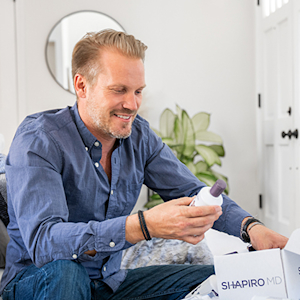Tretinoin for Hair Loss: What to Know
2022-06-17
Approved for medical use in 1971 by the U.S. Food and Drug Administration (FDA), tretinoin is a derivative of vitamin A.
Tretinoin was initially approved and prescribed for treating acne as a topical, and for acute promyelocytic leukemia (APL) in oral form.
Tretinoin's use has branched out significantly into a host of other conditions since: today, it’s among the most common topical prescriptions used by dermatologists to treat wrinkles, acne, fade scars, and even help stop hair loss and regrow hair. Because it’s not approved by the FDA for men and women in every one of these indications, it’s often prescribed “off-label” or included in custom topical formulas made by dermatologists in hair care clinics.
Tretinoin is incredibly versatile, including in helping men and women fight and stop hair loss. Here’s the story.

Summary
- Tretinoin is a man-made form of vitamin A in the class of similar substances called retinoids (these include retinol, retinal, and retinaldehyde). It’s available by prescription only and is used “off label” for hair loss. It must be prescribed by a physician or dermatologist.
- Topical tretinoin has been shown to help with hair loss, hair growth, and improved density. It’s believed to work by lengthening the time that hair follicles are in “grow mode” or the Anagen phase of the hair cycle.
- Research has also shown that tretinoin enhances the effects of topical minoxidil (Rogaine®) when the two are used together.
Tretinoin as a Hair Loss Treatment
Is Tretinoin FDA-approved for Treating Androgenic Alopecia?
The FDA has not yet approved tretinoin for promoting hair growth in adults with androgenic alopecia. Androgenic alopecia is the medical term for the most common form of hair loss in men and women: male pattern hair loss and female pattern hairloss.
However, dermatologists have been prescribing tretinoin as an off-label topical for treating hair loss since the 1990s.
Early clinical trials involving tretinoin's effectiveness against acne showed that tretinoin not only reduced acne outbreaks, but it appeared to cause an unexpected side effect—hair growth!
A 1986 investigation into tretinoin hair regrowth properties found that tretinoin used as a standalone treatment for androgenic alopecia stimulated hair growth in nearly 60% of study participants.
Combining tretinoin with minoxidil (another common topical hair loss solution) resulted in over 65% of participants experiencing hair regrowth.
Verdict: Tretinoin is not approved for hair loss by the FDA but is used off-label by many dermatologists and clinicians.
Does Topical Tretinoin Work to Regrow Hair?
Derivatives of vitamin A such as ATRA have been shown to trigger cell reproduction in the skin's epithelium (layer of cells comprising the epidermis).
Tretinoin also promotes blood flow to the epithelium, where hair follicles transition through the four stages of hair growth.
A 2007 study demonstrated the precise mechanism behind ATRA's hair growth properties—the ability to prolong the anagen (growth) phase of the hair cycle.
Although the anagen phase can last up to four years for individual hairs, adults with androgenic alopecia often suffer from a shortened anagen phase and longer telogen (resting) phases for their hair.
By lengthening the anagen phase, tretinoin keeps more hair on the scalp and reestablishes various degrees of hair thickness.
Verdict: Tretinoin lengthens the time that hair follicles are in “grow mode.”
Does Tretinoin Work With Minoxidil for Hair Loss?
Retinoids like tretinoin boost the effectiveness of minoxidil by promoting the release of an enzyme called sulfotransferase.
It’s believed that follicular sulfotransferase prolongs the survival of epithelial cells, improves absorption of minoxidil, and encourages hair growth.
It is for this reason involving follicular sulfotransferase that minoxidil does not perform as well by itself as it does when combined with tretinoin.
Currently, five percent minoxidil is approved for use in the U.S., Denmark, and Australia for men only.
Studies comparing the efficacy of two percent and five percent minoxidil on men with androgenic alopecia have found that five percent minoxidil increased hair count faster than two percent minoxidil. Some men participating in the study reported seeing visible results in two months when using five percent minoxidil.
Research involving the combined use of two percent minoxidil AND 0.05 percent tretinoin revealed that this amount of tretinoin significantly increased the absorption rate of minoxidil.
However, when five percent minoxidil was combined with two percent tretinoin, the results were nearly the same as when two percent minoxidil and 0.05 percent tretinoin were used on men with male pattern baldness.
Tretinoin can also be used in combination with oral finasteride, a medication that blocks the conversion of testosterone into dihydrotestosterone (DHT), the notorious “hair loss hormone.”
Verdict: Tretinoin combined with minoxidil is a potent combo for hair loss.
What Does It Mean for Doctors To Use a Medication "Off-Label"? Is It Safe to Use Tretinoin or Retinoids for Hair Loss?
According to the U.S FDA, physicians may prescribe a drug already approved by the FDA for use in conditions other than the one for which the drug was approved.
For example, tretinoin has been approved for treating acne, leukemia, and skin wrinkling due to photoaging.
When a dermatologist prescribes tretinoin for hair growth, that is referred to as "off-label" use.
Many physicians rely on the off-label use of medications to treat conditions that do not respond to medications approved by the FDA. However, doctors who prescribe drugs off-label are aware of multiple studies indicating that a drug is safe to use off-label.
Many medications used off-label usually receive FDA approval at some point for treating an "off-label" health problem.
Other medications routinely prescribed for off-label use are risperidone (FDA-approved for schizophrenia; used off-label to treat Tourette's syndrome and OCD) and Clomiphene (FDA-approved to increase female fertility; used off-label to treat low sperm count in men).
Verdict: Tretinoin can be deployed by trained clinicians and is often included in custom formulas from hair loss clinics.
Tretinoin is a Topical Retinoid. What Exactly are Retinoids?
Any substance referred to as a retinoid is derived from vitamin A.
Retinoids stimulate the production of elastin, collagen, and other substances that support skin health. They also increase rates of cell division to help reduce signs of photoaging.
Adults with psoriasis-related hair loss benefit from the ability of retinoids to decrease the inflammation and swelling associated with psoriasis that is responsible for hair loss.
All retinoids, including tretinoin, share a common list of side effects that peak at around three weeks before they start diminishing. Initially, many retinoid users experience local irritation and redness, followed by peeling, dryness, and itchiness.
Applying a small amount of a topical corticosteroid can ease these side effects without interfering with expected treatment results.
Although retinoids are not considered a true photosensitizing agent, the dryness and peeling it causes could exacerbate a person's susceptibility to sunlight and sunburn. Therefore, adults using tretinoin for hair loss may need to apply sunscreen on exposed scalp skin until desired hair regrowth is reached.
How to Use Tretinoin for Hair Loss
Use tretinoin cream or solution as prescribed by your dermatologist or physician.
Applying more tretinoin than prescribed likely won’t make your hair grow faster. In fact, excess tretinoin applied to the scalp could worsen side effects and interfere with normal hair regrowth.
Always clean your scalp regularly with mild soap and dry the areas thoroughly before applying tretinoin.
Spreading tretinoin on wet or damp skin may irritate the skin due to moisture preventing rapid absorption of tretinoin.
Use tretinoin for the prescribed length of time, even if you can’t tell right away that it's working.
It typically takes 2 - 3 months to see visible results, whether you use tretinoin alone or a combination of tretinoin and minoxidil. Individual results vary depending on the severity of androgenic alopecia.
Before using tretinoin, tell your dermatologist or physician if you are taking any one of the following:
- Diuretics
- Tetracycline
- Minocycline
- Doxycycline
- Antibiotics such as ciprofloxacin, lomefloxacin, or sparfloxacin
- Sulfa drugs (Septra or Bactrim)
- Chlorpromazine
- Promethazine
These medications increase the skin's sensitivity to the sun's ultraviolet rays and may raise the risk of sunburn or rash. Severe skin irritation may occur when tretinoin is used while you are taking medications containing salicylic acid, benzoyl peroxide, or resorcinol.
Temporary side effects are likely to occur. They are not serious and usually subside after using tretinoin for a short time. Common side effects of tretinoin include:
- Dryness
- Itching
- Stinging/burning sensation
- Swelling
- Redness
- Dryness/peeling
Tretinoin is available as a cream or gel. It comes in different percentage strengths ranging from 0.01 percent to 1 percent.
Where to Get Tretinoin for Hair Loss
Getting hair loss solutions that contain tretinoin is challenging unless you visit a dermatologist in-person.
Today, with telemedicine platforms like Shapiro MD, it’s easier than ever.
If appropriate, tretinoin is one ingredient deployed in our custom prescription hair loss formulas, which are selected and prescribed by our licensed clinicians based on your hair condition and situation.
Click here to learn more and get started.



